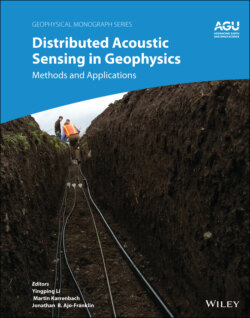Читать книгу Distributed Acoustic Sensing in Geophysics - Группа авторов - Страница 21
1.1.5. DAS Signal Processing and Denoising
ОглавлениеIn all phase‐detection schemes, the change in optical phase between the light scattered in two fiber segments is determined, meaning we are measuring the deterministic phase change between two random signals. The randomness of the amplitude of the scattered radiation imposes certain limitations on the accuracy of the sensor, through the introduction of phase flicker noise. The source of flicker noise is an ambiguity: when the fiber is stretched, the scattering coefficient varies, and can become zero. In this case, the differential phase detector generates a noise burst regardless of which optical setup is used. The amplitude of such noise increases with decreasing frequency (as is expected for flicker noise) when the phase difference is integrated into the displacement signal.
From a quantum point of view, we need, for successive phase measurements, a number of interfering photon pairs scattered from points separated by the gauge length distance. In some “bad” points, there are no such pairs, as one point of scattering is faded. A natural way to handle this problem is to reject “bad” unpaired photons by controlling the visibility of the interference pattern. As a result, the shot noise can increase slightly as the price for the dramatic reduction of flicker noise. The rejection of fading points can be practically implemented by assigning a weighting factor to each measurement result and performing a weighted averaging.
This averaging can be done over wavelength if a multi‐wavelength source is used. Alternatively, we can slightly sacrifice spatial resolution and solve the problem by denoising using weighted spatial averaging (Farhadiroushan et al., 2010). The maximum SNR is realized when the weighting factor of each channel is chosen to be inversely proportional to the mean square noise in that channel (Brennan, 1959), meaning the squared interference visibility, V2, can be used for the weighting factor as:
(1.21)
The averaging function p(z) = 5m should optimally be chosen to be compatible with the pulsewidth τ(z) = 50ns, which should be around half the interferometer length L0 = 10m. With this width of the averaging function, it has no significant effect on the spatial resolution of the DAS. Modeling with and without weighted averaging is presented in Figure 1.9, which demonstrates that significant noise reduction can be achieved. It should be noted that this noise reduction is particularly marked in comparison with the coherent OTDR response, by contrasting with Figure 1.5. Nevertheless, weighted averaging suppresses rather than completely removes the effect of flicker noise, and some channels still demonstrate excessive noise (in addition to shot noise). Hence, the response over all depths at a given time for Figure 1.9 will contain spikes for faded channels.
As is explored in Section 1.3, the problem of flicker noise can be overcome by introducing engineered bright scatter zones along the fiber with constant spatial separation and uniform amplitude. Such scatter zones also reflect more photons, and so improve the shot noise detection limitation. In addition, the use of such engineered fiber allows the use of phase‐detection algorithms with improved sensitivity and extended dynamic range.
Figure 1.9 The left‐hand panel shows modeling of raw DAS acoustic data (Equation 1.12); the right‐hand panel shows the same shot with weighted averaging denoising (Equation 1.13) applied. The signals’ cross‐section along the white line is shown in the bottom panels in radians. The modeled
source is shown in the right panel of Figure 1.5.
